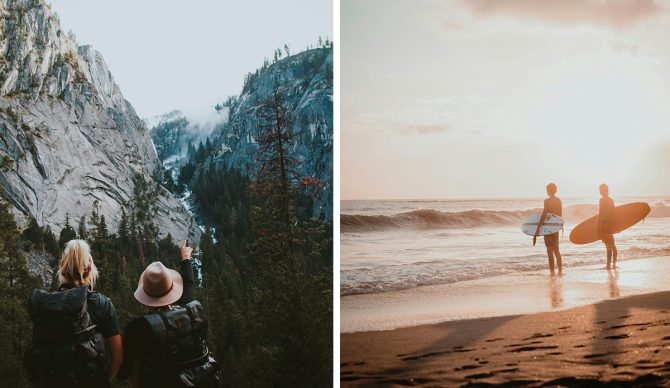
We naturally disregard the dangers in hiking. Photos: Unsplash
When I went on my first surf trip to the Mentawais two years ago, I bought some surf safety gear for the first time in my life. I got a helmet, reef booties, and a long-sleeved rashguard, hoping to mitigate the damage from the inevitable crash on coral that I was soon to experience. I couldn’t care less how cool (or un-cool) I looked.
And while I escaped with just a few minor scrapes and bruises, it got me thinking about how we view safety in surfing. There are dozens of ways to get seriously injured or die on a surfboard: shark attack, drowning, fin lacerations, collisions with other surfers, slams on rocks and reefs, bacteria in the water, etc. These are inherent risks in surfing, but in reality, they are rare, or at least rarely fatal.
The other extreme sport that I practice is hiking. I love a long, challenging hike that pushes my physical limits and gets me deep into the wilderness. On paper, hiking is a much safer option than surfing. A trail is relatively static compared to the treacherously shifting sea. Tossing yourself over a shallow ocean slab makes a stroll in the woods seem elementary. But upon closer inspection, the rather visual dangers of surfing, like a shark attack, provoke more of a visceral reaction towards an unlikely event, whereas the more probable, significant dangers of hiking are often overlooked.
Statistically speaking, hiking is a far more deadly sport. While it’s admittedly hard to compare the two sports apples to apples, surfing deaths worldwide are estimated to be around 10 per year. On the other hand, hiking deaths in U.S. national parks alone each year range from 120-150. There have been 1,300 deaths in Yosemite National Park since it was established in 1890. According to a study, in Switzerland, an average of 46 hikers died each year from 2003-2018. The National Center for Health Statistics says that the chance of dying while hiking in the mountains is 1 in 15,700, which is 6.4 times higher than skydiving. Sure, there are more hikers in the world than surfers, but not that much more to account for such a disparity.
As a journalist, I consume a lot of extreme sports news. And on a near-daily basis, I am bombarded with articles about hiking accidents and deaths. “Three Hikers Die in the Grand Canyon,” “Missing Hiker Found Deceased in San Diego,” “Hiker Plunges to Death on Treacherous Mountain,” etc.
Despite being inundated with grim hiking news, the dangers of surfing are more present in my mind. Tamayo Perry just succumbed to a shark attack. Mikala Jones and Eric Foraker recently passed away while surfing in the Mentawais, which hit close to home. I’ve been to those islands and surfed those consequential waves. It’s easy for me to imagine how the same could happen to anyone, or me.
My overweighed emphasis on the fears of surfing versus hiking reminds me of the irrational fear of plane crashes over car crashes. We are much more likely to die every time we get in our cars than when we board a plane, but we’ve all seen the videos of planes plummeting to Earth, a scene that is all too easy to visualize and stoke fear. Shark attacks, for example, have entire Hollywood films dedicated to them, elevating the perceived danger of surfing. The more common danger of succumbing to heat exhaustion or hypothermia on your average hiking trail doesn’t translate as well to triggering our brain’s sense of fear and danger.
When I go on a multiple-day hiking trip, I go through standard safety protocol. I bring a first aid kit, leave my itinerary with my family, and meticulously map out water sources. But I’ve noticed my safety gear is not commensurate with the risk compared to my surfing trips. For example, I’ve previously written about my hesitance (stupidity?) to purchase a satellite emergency device for hiking.
If I take anything out of this exercise, it’s to be diligent with my decision-making in the mountains like I am in the ocean. If your body isn’t feeling right, turn around. If the weather isn’t ideal, don’t stubbornly push for the peak. And, of course, all forms of hiking and surfing are not created equal. Surfing Maverick’s and hiking Everest are wholly different animals than surfing mushy Pleasure Point and walking on well-maintained trails. As I grow older, I’ve noticed that I’ve already become much more risk-averse in my outdoor activities, but it’s been useful to remind myself to continue to do so. The real risks of hiking should not be underestimated. Failing to realize that can be a deadly mistake.

